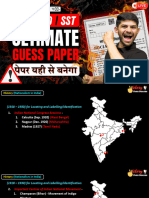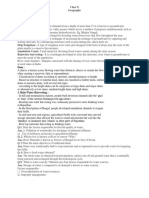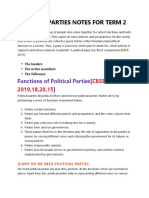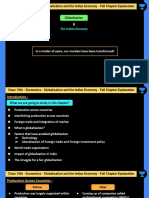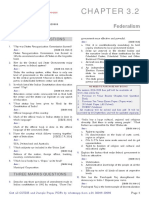0 ratings0% found this document useful (0 votes) 485 views3 pagesSST Question
Copyright
© © All Rights Reserved
We take content rights seriously. If you suspect this is your content,
claim it here.
Available Formats
Download as PDF or read online on Scribd
(i) On 12th March, Mahatma Gandhi began
his historic: march from ‘Sabarmaii Ashram
to Dandi, « village on the Gujarat seacoast
(ii) He was accompanied by 78 of his trusted
volunteers, but as Gandhiji: advanced.
others joined the pany
(iv) On the morning of 6th April, Gandhiji
violated the salt laws by picking up some
sail from the sea water. Gandhij's campaign
against the salt laws was a signal to disobey
the Government laws.
‘The Programme of the Movement: The
Civil Disobedience campaign involved defiance
of salt laws, beveott of liquor, boycott of
foreign cloth and British goods of all Kinds.
0.5. ‘Large sections of Muslims did not respond
to the call for a united struggle during the
Civil Disobedience Movement.” Explain,
Or
“Some of the Muslim political
organisations in India, were lukewarm in
their response to the ‘Civil Disobedience
Movement’.”” Examine the statement.
[CBSE 2013 (D))
Ans. (I) Association of Congress with Hindw
Mahasabha : Aiter the decline of the Non-
cooperation — Khilofat moverient, 2 targe
section of Musims felt alienated from the
Congress, From the mid-1920s, the Congress
came to be more visibly associated with
‘openly Hindi religious nationalist groups like
the Hindu Mahasabha
(W) Coramunal Clashes : As relations between
the Hindus and the Muslims wersened, each
‘community organised religous, processions
with militant fervour, provoking Hindu
Muslim communal clashes and rots in various
cities, Every riot deepened the distance
between the two communities,
(ip Issue of demand for seporate
electorates : Some of the Maslim leaders
demanded a separate electorate for the
Muslims which was not supported by the
Conaness leaders.
(iv) Status of Muslims in Hindu majority
‘state : Many Muslim leaders anc intellectuals
expressed their concern sbout the status of
Muslims as a minority within India, They
feared that the culture and identity of
minorities would be submerged under the
domination of e Hindu majority.
EVERGREEN Self-Study In Social Sclence-10..
i be Ce rare Ta
G.10, Explain the s of the Civil
7 Disobedience Movement tn the
countryside.
Why did the rich peasants of Uttar
Pradesh and Gujarat join the Civil
Disobedience Movement ?
tena March 2011)
Describe any three features of the Civil
Disobedience Movement of 1930.
(CBSE 2009 (0), ‘March 2012, 2013 (O))
r
Evaluate any three features of the peasant
movement during Civil Disobedience
Movement in India. [CBSE March 2011]
Or
Mention three reasons by which the rich
peasant communities took active part in
the Civil Disobedience Movement.
[CBSE 2012, 2019 (D))
Or
Describe the participation of the rich and
poor nt communities in the Civil
Disobedience Movement. (CBSE 2019(D)}
(In the countryside, ich peasant
communities-like the Patidars of Gujarat and
the dais of Uttar Pradesh were active
participants
(ii) They participated in the Movement because
they suffered the mast due to the economic
depression. As their cash income
disappeared, they found it impossible to pay
the government's revenue demand,
(lw) They demancied a reduction in revenue but
the government refused to do so. This led to
4 widespread resentment. These rich
landlords participated in the boycott
programmes, ond refused fo pay revenues,
For them, the fight for Swaraj was a stucale
‘against high revenues.
liv) But they were deeply disappointed when the
movement was called off in 1931_ without
the revenue rates being revised, So when
the movement wes restarted in 1982, many
of them did not participate�Or Or
How did ‘Non-cooperation Movement’ How did the peasants of Awadh ui
spread Im cities across the country ? different methods io achleve thelr goal ?
Explain its effects on the economic front. Explain. (CBSE 2014)
(CBSE 2015 (0), 2016(F)) Or
Or easants:
How did Non-Cooperation Movement start set ee ea cae
with particination of middle class tn the Rte 2015)
cities ? Expain its impact on the economic feoeeat:
front ICBSE 2018) or
Ans. () The movement in the cities: The jor problems faced
Movement started with middle-class Or the enadiae of monde Oe aap a
participation in the cities, Thousands of Non-Cooperation Movement.
students left government-controlled schools [CBSE 2015 (O))
and colleges, Resdmesters andl leathers 4.) pardicipante,sathaaalitt astieraie
resigned, and lawyers gave up their legal
practices:
(| Boycott of council elections: The
Council elections were boycotted in most
provinces except Madras (Chennai)
(Ww) Swadeshi
foreign cloth bumt in huge bonfires,
(v) Impact on industry : In many places,
merchants and traders refused to trade in
foreign goods or finance foreign trade, Due
to this, the demand of Indian textile mills
and handlooms went up. The increase in
relief to the
demand provided a
vanishing textile industry of India,
(0) Impact on trade; The import of foreign
cloth and its value halved.
Movement in the countryside.
{CBSE 2015 (0))
. Or
How did the Non-Cooperation Movement
Spread to the countryside.
[CBSE 2010 (F)|
Or
Describe the movement led by Baba Ram
Chandra in Awadh against the talukdars
and landlords, (CBSE 2012)
The Non-Cooperation
Movement had @ great impact on the Indian
textile industry. Swadeshi goods, especially
cloth got a great impetus. Foreign goods
‘were boycotted, liquor shops picketed, and
Explain the course of the Non-cooperation
movement was led by the peasants, tribals
and the local leaders. For example, in
Awadh, it was led by Baba Remchendra
‘sanyasi, who had earlier been to Fiji.as an
indentured labourer.
(i) Why did the rural people participate ?
The movement here was noi against the
Britishess but against lalukdars and landlords,
The problems of the rural people were
different from these of the urban people:
©The talukdars and landlords were
demanding very high rents and a variety of
other taxes,
® Peasants had to do begar and work at the
Jandiord's farms without any payment.
‘© The peasanis had no security of tenure, They
were regularly evicted so that they could
acquire no security of tenure.
As the problems of the people were different,
their demands were also different. The peasant
movement demanded :
@ Reduction of revenue
® Abolition of begar
© Redistibution of land
# Social boycott of oppressive landiords,
(ti), Ways of protests : The Movement in the
countryside had a different angle. In many.
places, Nal-dhobl bandhs were organised
by the Panchayats to deprive the landlords
of the services of barbers, cobblers,
washermen, etc. Even nationel leaders like
Jawaharlal Nehru went to villages in Awadh�to know the grievances of the people. By
October, the Oudh Kissan ‘Sabhas were set
up headed by Jawaharlal Nehru. Baba
Ramchandra, and a few others.
When the movement spread i 1921, the
houses of talukdare and merchants were
attacked. The movement turned violent
which was not liked by some of the Congress
leaders,
0.6. Analyse any four features of Gudem
rebellion of Andhra Pradesh.
[CBSE March 2011, 15)
Or
Explain the main features of Gudem
rebellion. (CBSE 2014]
Or
Desctibe the contribution made by Allurl
Sitaram Raju to the Non-Cooperation
Movement in Andhra Pradesh.
ICBSE 2014)
Or
“Tribal peasants interpreted the message
of Mahatma Gandhi and the idea of
‘Swaraj’ In yet another woy”. Support the
statement with suitable examples.
{CBSE 2016 (F) Compt.)
‘Ans. (i) The Gudem rebellion spread in response to
the Non-Cooperation Movement in 1921.
{ii) In the Gudem Hills of Andhra Pradesh, a
militant guerrila movement spread in the
early 1920s under the leadership of Alluri
‘Sitaram Raju against forest laws.
(iti) The rebels prociaimed that he was an
incarnation of God as he could make correct
astrological predictions and heal people.
iv) Raju talked of the greatness of Mahatma,
Gandhi and was inspired by Non-
Cooperation Movement, and persuaded
people fo wear Khadi and give up drinking.
But al the same time he asserted that India
Disobedience or the Salt Movement wos
Pace eis IGESE YES 10)
28. Explain the course of the Salt
Lahore Cangress formelined the den
‘Puna Swaral ot ful independence for |
Ih was declared that 26th Jantar, 2
would be ‘celebrated as the Indepen
Dey when people were to take @ ple
struggle for complete Independence
celebrations attracted very litle attention
‘Mahala Gandhi had to find a way to
this absiract dea of freedom tos
concrete issues of everyday life
(ii) Rejection of Gandhi's —
Demands : On Bist January,
Mahatma Gandhi, in a state!
forward Eleven Demands to. cor
‘wrongs done to the Indians.
He assured the Viceroy that he w
withdraw the Civil Disobedience on
‘Government's acceptance of these der
However, Gandhi's demands were decla
tobe unrealistic by the Viceroy.
(Wu) Economie Causes : The Great D
agricultural produce began to
and collapsed after 1930. aie
for agricultural goods fell and ¢
declined, peasants found it
decided to provide
Givil Disobed
launched. lence










